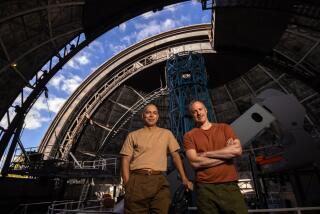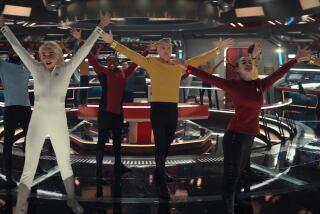ELECTRONIC ODE TO HALLEY’S ‘RETURN’
- Share via
When Morton Subotnick conceived the idea of a musical ode to Halley’s Comet, he knew from the start that an old-fashioned concert hall setting was simply out of the question.
“I just love the fact of the sky and all the stars being right there overhead and all around,” the New Mexico-based composer commented about the setting for the world premiere of “Return,” which he will oversee on Monday night as part of the Chamber Music in Historic Sites series.
No, his audience will not be shivering in the cold. The 45-minute electronic tone poem was assembled for performance at a planetarium--on this occasion, the one at 51-year-old Griffith Observatory.
“The seating situation is just ideal,” Subotnick said in a telephone interview from his home in Pecos. While the artificial sky will produce a few special effects (including, of course, occasional comet sightings), the dome will not, alas, accommodate his original concept for the slam-bang finale.
“I saw the entire sky begin to rotate until it was whirling about at a blinding speed, then gradually slowing down to a stop,” he said. “But then I talked with John (Mosley, program supervisor at Griffith Observatory), and he explained that it was physically impossible to rotate the sky that fast.”
Nonetheless, Subotnick remained excited about the piece, which will be repeated later this year at the Rochester, N.Y., planetarium and packaged there for sale to observatories around the country.
“Most of the piece just flowed out,” he said. “I’ve got three-part chant music, some snippets of two Scarlatti sonatas, some Haydn, some Mozart, some Lisztian gyrations and a fragment of a 1910 rag.
“At the end, you should say, ‘Gee, that didn’t seem like 45 minutes.’ ”
The work grew out of the composer’s desire to return to electronic composition.
“With all the new computer technology, I felt it was time to do another electronic piece,” he said.
“Then I thought about the comet. The piece started out simply being about the comet, but then I got the idea to hit those certain key points in our history when it returned (hence the title).
“The music--like the comet itself--involves this whole cyclic thing. Think of the timelessness of space compared to us. We are not cyclical: We are here and we disappear. I began to think about the magnitude and joy of human reason that goes beyond anything that has to do with one’s own lifetime.
“I used the Scarlatti sonata as a basis for glorifying human reason. More than anything, the form he used was the elixir for the Age of Reason--even more so than Mozart. I figured, if I could come up with a 45-minute piece with the power of a two-minute Scarlatti sonata, I will have created my own elixir.
“I worked out a two-part piece built around the cadences from two Scarlatti sonatas and subtitled it ‘The Triumph of Reason.’ ”
Though “Return” may sound fairly complex, it isn’t, Subotnick insisted. Just think of the two great evolutionary calamities in Earth’s history--one already past, one yet to come--and you get the picture, he said.
“Part 1 will end with the Dance of the Dinosaurs, which culminates in a Dance of Destruction. The fall of the dinosaurs was necessary, because it allowed the mammals to rise. I have a kind of clearinghouse view of evolution.
“Part 2 takes us right to the present, where we find ourselves in an explosive clash of the three worlds (West, East and the so-called Third World). Once again, I’ll call up the Dance of the Dinosaurs. I don’t view the (destructive) climax with pessimism--it’s simply inevitable.
“The advances we realized in the 18th to 20th centuries are only a prelude to the future.
“I just hope the weasels that succeed us will have some brains.”
More to Read
The biggest entertainment stories
Get our big stories about Hollywood, film, television, music, arts, culture and more right in your inbox as soon as they publish.
You may occasionally receive promotional content from the Los Angeles Times.










